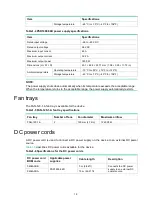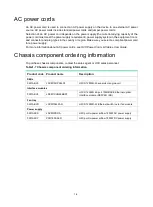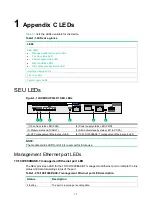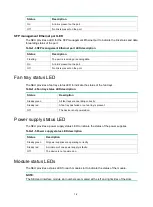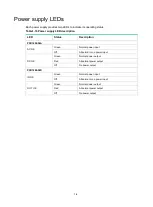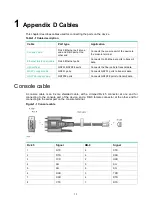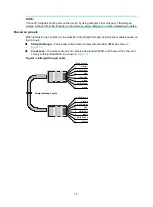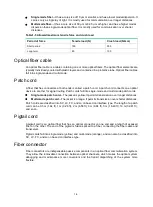
1-5
Pin
10BASE-T/100BASE-TX
1000BASE-T
Signal
Function
Signal
Function
3
Tx+
Send data
BIDA+
Bi-directional data cable A+
4
Reserved
N/A
BIDD+
Bi-directional data cable D+
5
Reserved
N/A
BIDD-
Bi-directional data cable D-
6
Tx-
Send data
BIDA-
Bi-directional data cable A-
7
Reserved
N/A
BIDC+
Bi-directional data cable C+
8
Reserved
N/A
BIDC-
Bi-directional data cable C-
To ensure normal communication, the pins for sending data on one port should correspond to the
pins for receiving data on the peer port. To connect two ports of the same connection type (MDI to
MDI or MDIX to MDIX), use a crossover Ethernet cable. A cross-over cable connects devices of the
same type. To connect two ports of different connection types (MDI to MDIX), use a straight-through
Ethernet cable. A straight-through cable connects devices of different types.
An RJ-45 Ethernet interface with MDI/MDIX autosensing enabled can automatically negotiate pin
roles. The S12500R-2L RJ-45 Ethernet interfaces support MDI/MDIX. By default, MDI/MDIX is
enabled on a port.
Making an Ethernet twisted pair cable
1.
Cut the cable to length with the crimping pliers.
2.
Strip off an appropriate length of the cable sheath. The length is typically that of the RJ-45
connector.
3.
Untwist the pairs so that they can lie flat, and arrange the colored wires based on the wiring
specifications.
4.
Cut the top of the wires even with one another. Insert the wires into the RJ-45 end and make
sure the wires extend to the front of the RJ-45 end and make good contact with the metal
contacts in the RJ-45 end and in the correct order.
5.
Crimp the RJ-45 connector with the crimping pliers until you hear a click.
6.
Repeat the above steps with the other end of the cable.
7.
Use a cable tester to verify the connectivity of the cable.
Optical fiber
CAUTION:
Use the same types of transceiver modules, pigtail cords, patch cords, and fiber cables. If you use
single-mode optical fibers, the transceiver modules, pigtail cords, patch cords, and fiber cables must
be single-mode.
Optical fiber
Optical fibers are widely used in fiber-optic communications, which are advantageous for
long-distance communications.
Optical fibers can be classified into the following types:



